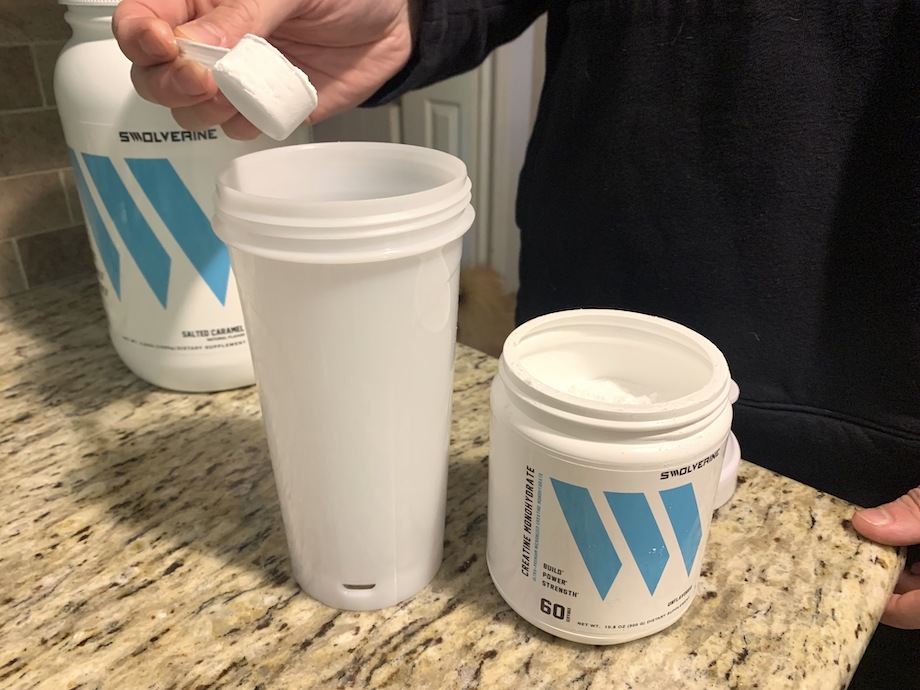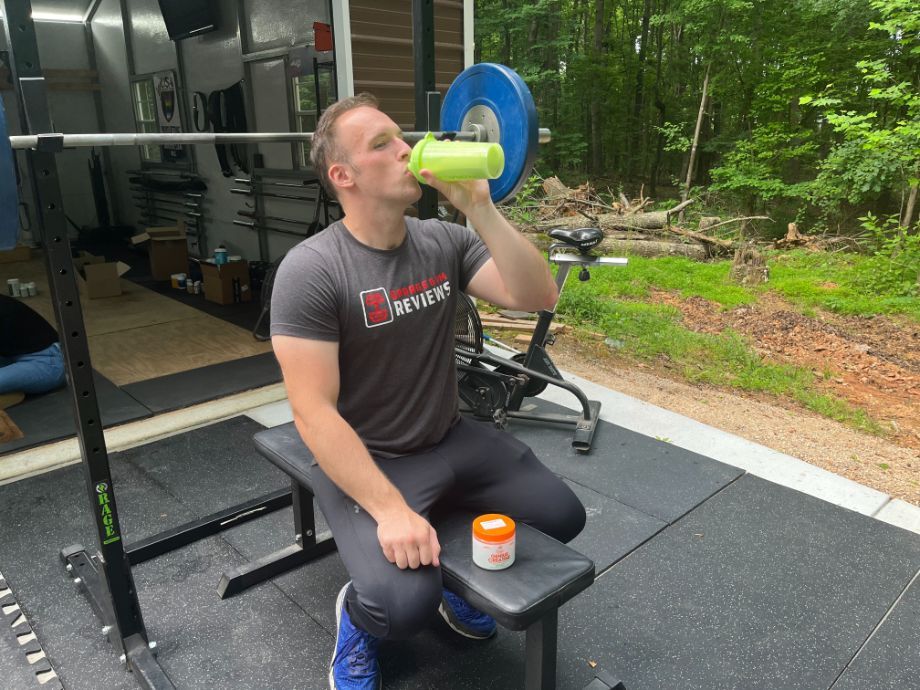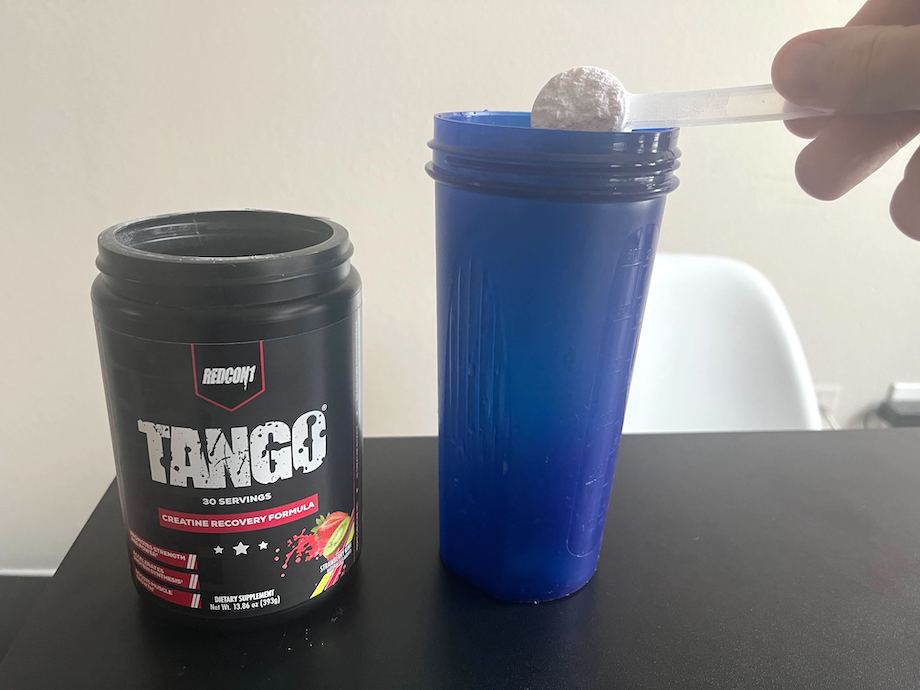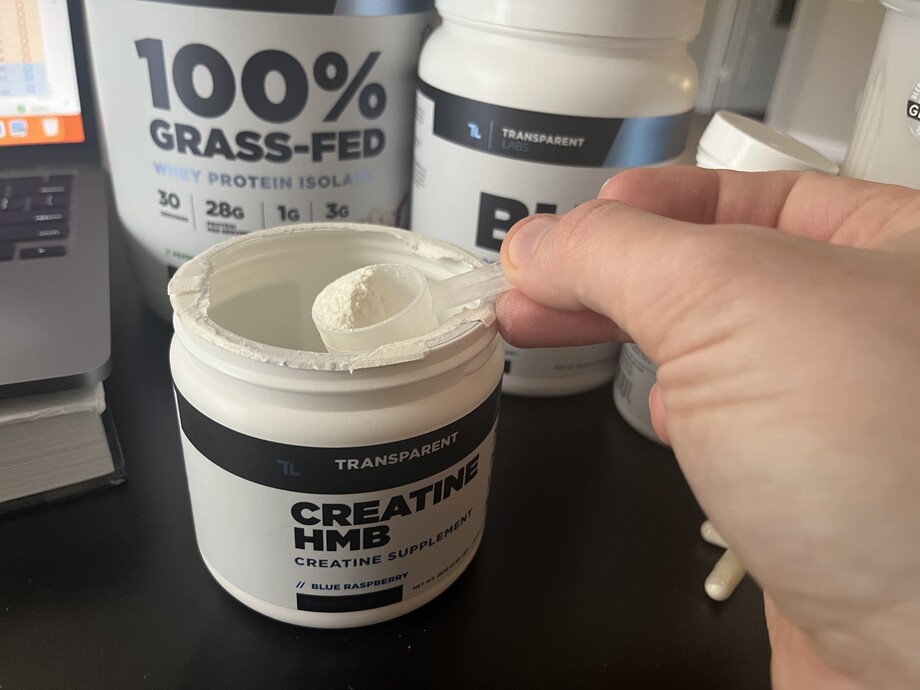We test and review fitness products based on an independent, multi-point methodology. If you use our links to purchase something, we may earn a commission. Read our disclosures.
I might be showing my age a bit, but I don’t have TikTok. I do have other social media accounts, many of which repost lots of TikTok trends; one of the more recent trends to pop up in the fitness world is dry scooping creatine and other supplements. Typically, creatine supplements are ingested by mixing with water or another liquid first, but many fitness influencers are saying that dry scooping creatine makes the supplement more effective.
Although it’s gaining traction now, I remember back in my early days of competitive weightlifting, being knee-high to a grasshopper (showing my age again), that this was a common practice amongst top bodybuilders and elite weightlifters. It was a sign of strength to take dry powder and gulp it down without flinching—although there was often a lot of flinching and coughing.
Can you dry scoop creatine? The question is less if you can, and more if you should. Let’s explore this topic—whether there are any health benefits or potential risks to dry scooping creatine—with some helpful insight from USA Weightlifting sports dietitian Meagan O’Connor, RD. (Spoiler alert: the short answer is you probably shouldn’t!)
Medical disclaimer: This article is intended for educational and informational purposes only. It is not intended as a substitute for medical advice. For health advice, contact a licensed healthcare provider.
Why Are So Many People Dry Scooping?
The act of dry scooping pre-workout supplements and other sports supplements has become a trend on social media platforms, particularly the ever-popular TikTok. While social media can provide some really cool and smart ideas and challenges, they can also provide some really uncool and bad ideas. Akin to challenges like the cinnamon challenge or the Tide Pod challenge, dry scoop challenges should best be avoided.
If it’s not the smartest choice, why are so many people doing the challenge? Some influencers think that taking creatine or other supplements without liquid will allow the creatine to enter directly into the bloodstream through the mucus membranes of your mouth, providing a quicker “hit” and increasing the effectiveness of creatine.
Another reason people are dry scooping is for the social media interaction: likes, shares, and follows. Many on social media will perform and post trending challenges in the hopes of garnering a larger audience.
While it can seem harmless at first, dry scooping can have some potentially dangerous risks, which makes it all the more concerning how many people are hopping on this bandwagon. A study from this year1 showed that nearly 17% of adolescents surveyed reported dry scooping supplements.
What Is Creatine?
Creatine2 is a naturally occurring amino acid stored in muscle tissue and the brain as well. It’s found in natural proteins like meat and fish, but is also produced in the liver, kidneys, and pancreas. Its role in the body is to help replenish ATP (adenosine triphosphate), which is your body’s energy source for explosive movements and muscle contractions, for action like sprinting or lifting weights.
RELATED: Crazy Nutrition Ultimate CRN-5 Review
Because creatine is linked to muscle energy, people take creatine to help improve athletic performance and to build muscle mass. Creatine is the most researched supplement3 and has been shown to help in muscle-building and strength in athletes who routinely lift weights.

There are different types of creatine—creatine hydrochloride, creatine HMB, creatine phosphate—but the most popular and most researched is creatine monohydrate. Typically, creatine comes in either an unflavored powder, capsule, or gummy form, although it can be added to other supplements, like pre-workout or BCAA.
RELATED: Best Pre-Workout With Creatine
Potential Side Effects
Studies show4 that both short-term and long-term creatine supplementation is safe for healthy individuals. When taken with water, there is very little risk in taking creatine powder.
The biggest side effect of taking creatine is a chance for gastrointestinal distress, according to Meagan. This can lead to issues like stomach cramps and diarrhea, among other problems. A 2008 study5 showed that the risk of digestive issues can be increased with a larger amount of creatine in a single serving (taking 10 grams of creatine all at once instead of 5 grams). Meagan’s advice to help avoid digestive issues is to “try taking creatine with food and fluid in your system, rather than on an empty stomach.”

Many people claim another side effect of creatine is muscle cramps and similar symptoms of dehydration. It’s simply not the case; creatine actually does the opposite, helping draw water into muscle cells. “Creatine draws water into the cells, meaning you retain more water in your body when you start taking creatine,” Meagan says. Still, she says to focus on adequate hydration whether or not you’re taking creatine at the moment.
Is There Any Benefit to Dry Scooping Creatine?
Although many influencers and athletes will swear that having a scoop of creatine without water makes the absorption of creatine faster and more effective, there’s no research to back this claim up. No studies or scientific evidence show any additional benefits of dry scooping creatine when compared to ingesting it normally with water or another liquid.
When I asked Meagan about any benefits, she reluctantly added it could maybe save a little bit of time, but then strongly advised to have creatine with water regardless. Unlike there being no benefits to dry scooping creatine, there are quite a few potential risks to the practice, which far outweigh any time saved.
What Are the Risks to Dry Scooping?
Because creatine in powder form is often pure, there aren’t as many potential risks as a supplement with multiple ingredients, like pre-workout powders or muscle recovery supplements. However, there are still quite a few risks involved with dry scooping pure creatine.
RELATED: Creatine vs Pre-Workout
Be mindful that taking a creatine supplement with additional ingredients will only compound and add to any potential risks and side effects as well.
Inhalation and Choking
The most obvious danger is that having powdered supplements without a glass of water has a chance of not going down easily. You can gag the powder and cough, or even worse, inhale the powder, which could lead to irritation, trouble breathing, or even choking. Your lungs prefer air over creatine powder, and inhaling it can be irritating, potentially causing lung damage as well. The risk of choking just isn’t worth it.
Supplement Wastage
Remember the cinnamon challenge? I sure do; my brother had me do it without telling me what it was (thanks brother!), and the results weren’t pretty. I gagged and coughed almost immediately, sending cinnamon powder dust everywhere.
If you cough or choke while dry scooping creatine, you have a good chance of doing the same thing; coughing up supplement powder everywhere, and wasting a good amount of creatine powder. Wasting supplements like this is essentially wasting your money; to get the most value out of your supplements, make sure to take it properly, to avoid losing servings that cost money.
Digestive Issues
As Meagan said before, taking creatine has a chance to cause gastrointestinal issues in some people. According to a 2015 study6, this issue can be exacerbated when not having enough fluids. That’s because your stomach and gut will have to pull water in to help digest the supplement, and this sudden shift in fluids is what can lead to stomach discomfort, bloating, and other digestive issues.
When you dry scoop creatine, you are taking it with no fluids. Not just “not enough” fluids, but no fluids at all, so by not having creatine with even a sip of water (or more), you’re essentially setting yourself up for a good chance to have some stomach issues shortly after.
Tooth Decay
Creatine and other supplements can often include additives such as citric acid and malic acid. Research7 has shown that citric acid exposure can increase the erosion of enamel on your teeth. When you dry scoop creatine with citric acid or a similar acid, you are exposing your teeth to a concentrated dose, which can eventually weaken your enamel and teeth. Over time, this can lead to tooth decay.
A simple solution? Dilute your creatine.
How To Use Creatine Safely
The safest way to use creatine safely is to use it as it was intended: with water or another liquid. Oftentimes creatine is unflavored, so adding it to any liquid is possible without messing with the flavor too much. If you’re tired of having it with water, you can add creatine to a protein shake or sports drink.

When it comes to dosage, creatine is often taken as loading dosage first, to help saturate stores of creatine in the body, according to a 2021 study from the Journal of the International Society of Sports Nutrition8. The dosage is recommended to be between 20 and 25 grams per day, broken up into four or five doses each day. This loading dosage is done for five to seven days.
After that, the International Society of Sports Nutrition9 recommends a lower maintenance dose, usually 3 to 5 grams of creatine per day. This will depend on the person though; a larger athlete may need as much as 5 to 10 grams per day to maintain creatine stores.
RELATED: How Long Does Creatine Stay In Your System?
Can You Dry Scoop Creatine? Final Thoughts
Simply put, you shouldn’t dry scoop creatine. To get all the performance benefits of creatine without any of the potential risks of dry scooping, just mix creatine with water or another liquid. There’s no scientific evidence showing that dry scooping any supplement can improve its effectiveness, so don’t hop on the dry scoop challenge. The risks outweigh the likes and follows.
Can You Dry Scoop Creatine? Q&A
Can you take creatine without water?
You can absolutely substitute water with any liquid, as most creatine is unflavored; it won’t affect the flavor of your sports drink or beverage. If, however, you mean to take creatine without any liquid, you run the risk of inhalation and choking on the creatine powder. Additionally, taking a concentrated, undiluted dose of a supplement can cause digestive issues. I wouldn’t recommend taking creatine without mixing it in a liquid first.
Is it okay to dry scoop protein powder?
Protein powder, along with any supplement powder, shouldn’t be dry scooped. There are no additional benefits from dry scooping supplements, but plenty of potential risks, like choking or an increased chance of gastrointestinal problems.
RELATED: Best Protein Powder
Is it okay to add creatine to your cereal?
While a little unorthodox, creatine can dissolve in most any liquid, so it can be mixed in with your cereal milk and ingested that way. If you’re tired of having it with just water, I’d consider mixing it with a protein shake or sports drink first, though, before resorting to your cereal.
These statements have not been evaluated by the Food and Drug Administration. This product is not intended to diagnose, treat, cure, or prevent any diseases.
References
- Ganson KT, Hallward L, Testa A, Jackson DB, Nagata JM. Prevalence and correlates of dry scooping: Results from the Canadian Study of Adolescent Health Behaviors. Eat Behav. 2023 Jan;48:101705. doi: 10.1016/j.eatbeh.2023.101705. Epub 2023 Feb 6. PMID: 36764046.
- Creatine. Mayo Clinic. Feb 9, 2021.
- Wu SH, Chen KL, Hsu C, Chen HC, Chen JY, Yu SY, Shiu YJ. Creatine Supplementation for Muscle Growth: A Scoping Review of Randomized Clinical Trials from 2012 to 2021. Nutrients. 2022 Mar 16;14(6):1255. doi: 10.3390/nu14061255. PMID: 35334912; PMCID: PMC8949037.
- Hall M, Manetta E, Tupper K. Creatine Supplementation: An Update. Curr Sports Med Rep. 2021 Jul 1;20(7):338-344. doi: 10.1249/JSR.0000000000000863. PMID: 34234088.
- Ostojic SM, Ahmetovic Z. Gastrointestinal distress after creatine supplementation in athletes: are side effects dose dependent? Res Sports Med. 2008;16(1):15-22. doi: 10.1080/15438620701693280. PMID: 18373286.
- Zhang X, O’Kennedy N, Morton JP. Extreme Variation of Nutritional Composition and Osmolality of Commercially Available Carbohydrate Energy Gels. Int J Sport Nutr Exerc Metab. 2015 Oct;25(5):504-9. doi: 10.1123/ijsnem.2014-0215. Epub 2015 May 20. PMID: 25997181.
- J. Zheng, F. Xiao, L.M. Qian, Z.R. Zhou. Erosion behavior of human tooth enamel in citric acid solution. Tribology International, Volume 42, Issues 11–12. 2009: 1558-1564 ISSN 0301-679X. https://doi.org/10.1016/j.triboint.2008.12.008.
- Gann JJ, McKinley-Barnard SK, Andre TL, Schoch RD, Willoughby DS. Effects of a traditionally-dosed creatine supplementation protocol and resistance training on the skeletal muscle uptake and whole-body metabolism and retention of creatine in males. J Int Soc Sports Nutr. 2015 Sep 21;12(Suppl 1):P2. doi: 10.1186/1550-2783-12-S1-P2. PMCID: PMC4594933.
- Kreider RB, Kalman DS, Antonio J, Ziegenfuss TN, Wildman R, Collins R, Candow DG, Kleiner SM, Almada AL, Lopez HL. International Society of Sports Nutrition position stand: safety and efficacy of creatine supplementation in exercise, sport, and medicine. J Int Soc Sports Nutr. 2017 Jun 13;14:18. doi: 10.1186/s12970-017-0173-z. PMID: 28615996; PMCID: PMC5469049.
Further reading

We asked a certified strength and conditioning coach to build a beginner core workout with the best core exercises to boost strength and sculpt your abs. Read more

In our Noom review, get a glimpse at what it’s like to use the service, and how it could—or could not—work for you. Read more

Have you ever heard the expression “less is more?” Isometric exercises prove it by requiring less movement to unlock more strength gains. Find out more now! Read more

Looking to improve your form or speed? Your running cadence could play a role in both. Read more

